When it comes to fish and aquaponics, there’s the good, the bad, and the ugly.
Some fish — like Tilapia — have an extremely high tolerance range and can flourish even in the worst of conditions, and then some fish — such as trout — have very specific requirements, making them a tad bit difficult for beginners.
Ideally, if you want to be successful in aquaponics, pick a fish that’s easy, hardy, and suitable for your particular environment.
So, without further ado, here’s our big list of edible fish, ornamental fish, and challenging fish suited for aquaponic systems.
Have you successfully raised fish in aquaponics? Do you have something to highlight? Share your story with us so we can publish it and tell the world how you did it!
Table of Contents
- Best Edible Fish
- Tilapia
- Catfish
- Bluegill
- Pacu
- Carp
- Yellow Perch
- Best Ornamental Fish
- Koi
- Fancy Goldfish
- Guppies
- Angelfish
- Tetras
- Mollies
- Swordtail
- Danios
- Cichlid
- Clown Loach
- Challenging Fish
- Barramundi
- Walleye
- Hybrid Striped Bass
- Largemouth Bass
- Trout
- Salmon
- Murray Cod
What You Need to Think About Before Picking Your Fish
When it comes to making your fish selection, there are several things you need to take into consideration. So before you do anything, make sure you read this list and see if aquaponics works for you.
Is the Fish Edible
If you’re wanting to eat your fish, then you’re going to want to pick a fish that’s (1) edible and (2) that you personally enjoy eating. For beginners, your primary edible choices are Tilapia, Catfish, Bluegill, Pacu, Carp, and Yellow Perch.
Do You Intend to Sell the Fish
The great thing about aquaponics is that you get to grow fish and plants together in one continuous, natural, recirculating system. That means that whatever fish you pick, you also have the ability to sell it. And if this is your goal, then make sure to pick a fish that’s (1) easy to grow, and (2) has a high market value in your particular area.
Temperature Considerations
Temperature is huge in aquaponics and certain fish have very specific temperature ranges. If growing outdoors, make sure your fish is suitable for your climate and environment.
Fish Availability
As you’ll quickly learn in aquaponics, sometimes your fish selection is really a matter of availability. So before you even think about buying anything or setting anything up, you need to first make sure that the fish you want to raise is available in your area. The best way to find your fish is to simply google “fish hatchery near me” and make some phone calls.
Fish and Lighting
When it comes to fish and lighting, you need to cover your tank in some manner to give the fish shade and prevent algae growth. However, depending on what fish you’re growing, some species may need more shade than others. Make sure to do your due diligence and select a fish that’s suitable for your space and tank.
Breeding Considerations
Breeding is tricky within tanks and it varies from fish to fish. But if breeding is something you want to happen, make sure you understand your fishes breeding habits and needs before making your selection.
Size and Grow Rate
Some fish can take years to reach their harvestable size while some take a matter of months. When it comes to your fish, pick one that’s suitable for your tank space. Additionally, just remember to always do your stocking calculations based on the harvestable or adult size of your fish.
Space and Capacity
Depending on where you live and your personal lifestyle, caring for fish in aquaponics can be either easy or very difficult. Before getting started, just make sure to think about (1) where you can put your setup and if you have space, and (2) your personal availability for daily maintenance. If you don’t have the personal capacity to care for your fish, then you probably shouldn’t pursue aquaponics.
Water Quality Considerations
Maintaining water quality in your system is everything. If your water quality is bad, you’re going to have some problems (and maybe some dead fish!). So when you make your selection, pick a fish that can withstand a little bit of bad water quality — such as Koi — to give yourself a little wiggle room while you’re learning the ropes!
Feeding Considerations
Feeding is a big deal in aquaponics and some fish are heavy eaters! Whatever fish you choose, make sure you have a good understanding of their diet and answer a few questions before making your purchase: how many times they need to be fed, where to get fish food, fingerling vs adult amounts, etc.
Best Edible Fish For Aquaponics
The great thing about aquaponics is that you have the ability to produce fish and plants simultaneously in one continuous, natural, recirculating system. What’s even better, however, is that depending on your goals and needs, you can include edible fish within your system, making aquaponics a one-two punch option for growers.
Here’s our list of the best edible fish for aquaponics!
1. Tilapia
Tilapia are, hands-down, the best and most popular species to raise in an aquaponics system. They’re hardy, can handle a lot of stress, and can survive temperatures as low as 50 degrees Fahrenheit. Additionally, they’re able to be stocked at a high level and can be harvested in less than a year.
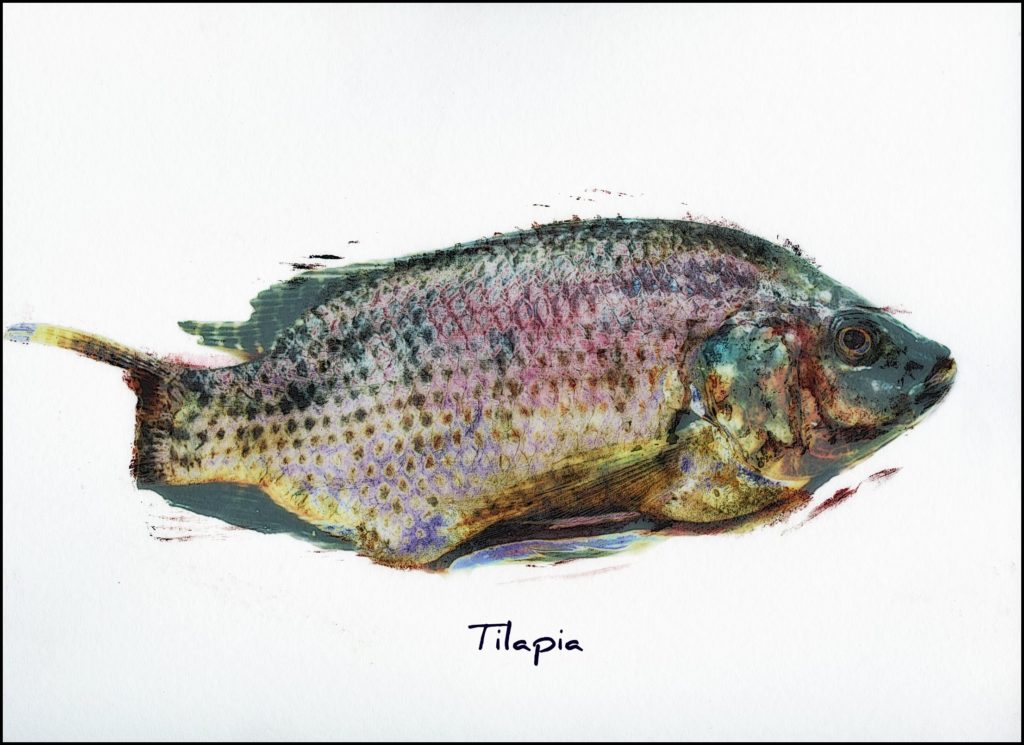
- Ideal Water Temperature: 81 to 85 degrees (F)
- Ideal pH: 6.5 to 9
- Omnivorous or Carnivorous: Omnivore
- Harvest Size: 15 to 20 ounces
- Harvest Rate: 8 and 1/2 months
- Stocking Density: 0.5 to 1 fish per sq ft of water
- Light Requirements: Small amounts
- Backyard or Commercial: Both
- Can be Bred within Tank: Yes
- Hardiness: Great
- Availability: Easy to find
- Can Mix with Other Fish: Yes
Advantages
- An extremely hardy fish with good survivability
- Potential for high stocking density
- Is good tasting (can flavor the fish fairly easily)
- Fast reproduction rates
- Great for beginners and commercial growers alike
Disadvantages
- Reproduction habits may overwhelm small aquaponic systems
- Tilapia are sometimes regulated in certain states/countries that consider them invasive
2. Channel Catfish
Catfish are also popular in aquaponic systems. They are a fairly hardy fish (but not quite as hardy as tilapia) and can withstand most environmental changes. Typically, although not always, catfish are readily available and easy to find, making them a great fish for beginners and those building their own DIY aquaponic system.

- Ideal Water Temperature: 75 to 85 F
- Ideal pH: 7 to 8
- Omnivorous or Carnivorous: Omnivore
- Harvest Size: 2 to 3 pounds
- Harvest Rate: 18 months to 24 months
- Stocking Density: 1 pound per 8 gallons
- Light Requirements: Natural lighting and shade
- Backyard or Commercial: Both
- Can be Bred Within Tank: Yes
- Hardiness: High
- Availability: Easy to find
- Can Mix With Other Fish: Yes
Advantages
- Catfish are edible and delicious
- Very hardy fish and can handle environmental changes
- Catfish have a fast growth rate
- They are easy to find and can be locally sourced
- Can be raised with other fish such as tilapia
Disadvantages
- Catfish prefer and need large tanks with more horizontal space
- Can be difficult to handle (picking up)
- Have cannibalistic tendencies in tanks
3. Blue Gill (also known as Sunfish and Brim/Bream)
Bluegill are great for aquaponic systems. They’re small, hardy, and easy to find. They can be harvested in as little as 12 months and don’t require a lot of tank space. Additionally, because they don’t like sunlight, bluegill are safe to raise in tanks without a window (the light from the top of the tank should suffice).
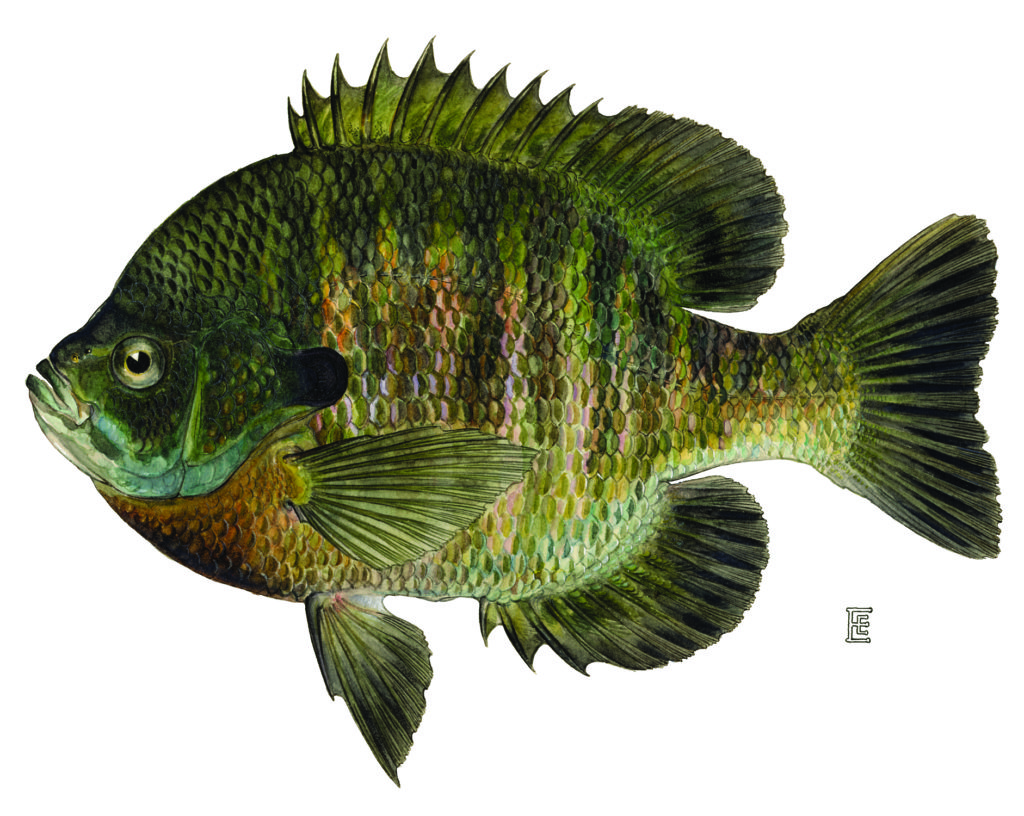
- Ideal Water Temperature: 64 to 79 (F)
- Ideal pH: 6.5 to 8.5
- Omnivorous or Carnivorous: Omnivorous
- Harvest Size: 6 or more inches
- Harvest Rate: 12 to 16 months
- Stocking Density: 1 pound per 10 gallons
- Light Requirements: No direct sunlight
- Backyard or Commercial: Both
- Can be Bred Within Tank: Yes
- Hardiness: High
- Availability: Easy to find
- Can mix with other fish: Yes
Advantages
- Extremely easy to harvest and handle
- Great for small, backyard aquaponic setups
- Great fish if you don’t plan on selling them (can live for seven years)
Disadvantages
- Have a tendency to cannibalize their offspring
- Illegal to be sold as fish food in some states
- Can take more than 2 years to reach 1 pound
- Have a big appetite and can be pricey to feed
4. Pacu
Not to be confused with the piranha (their not-so-distant cousin), pacu are great for aquaponics and can be harvested in just a few months. However, due to unique nature and space requirements, they’re better suited for commercial systems than backyard setups.
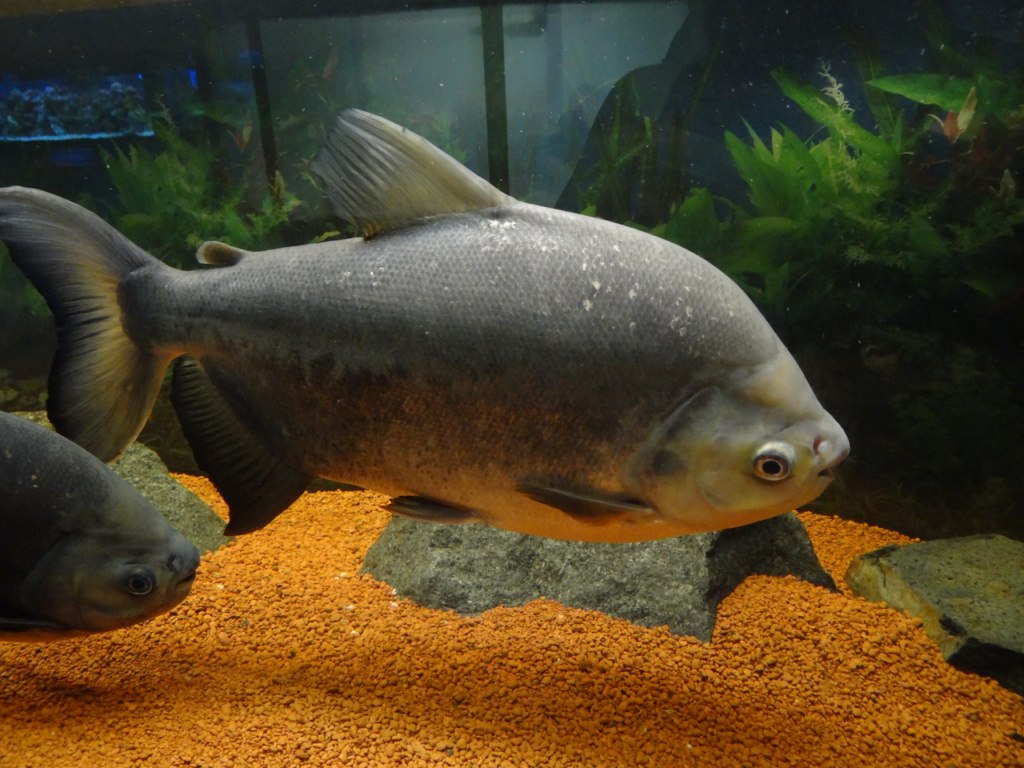
- Ideal Water Temperature: 72 to 84 (F)
- Ideal pH: 6.5 to 7
- Omnivorous or Carnivorous: Omnivorous
- Harvest Size: 1.5 pounds
- Harvest Rate: 7 months
- Stocking Density: 1 fish per 10 gallons
- Light Requirements: Natural lighting with shade
- Backyard or Commercial: Commercial
- Can be Bred Within Tank: Very difficult
- Hardiness: High
- Availability: Not easy to find
- Can mix with other fish: No
Advantages
- Lean, good tasting meat
- Grow extremely fast in aquaponic systems
- Hardy fish with good survivability
- Great for commercial aquaponics
Disadvantages
- Can be difficult to handle and can cause injury
- Hard to find in certain states/countries and highly regulated
- Can’t mix with other fish
- Requires a lot of space (but great for pond setups)
- Have high protein diets and need to be fed often (2 to 3 times per day)
5. Carp
Generally speaking, carp aren’t exactly popular among aquaponic farmers, but that doesn’t mean you should avoid them altogether (and there’s no reason why you can’t experiment with them if you’re a beginner). Just like Tilapia, they have great hardiness and high survivability. Additionally, while most people think of carp as an inedible fish, this isn’t exactly true either. In some areas, carp are regularly harvested and considered a delicacy!

- Ideal Water Temperature: 75 to 82 (F)
- Ideal pH: 7.5 to 8
- Omnivorous or Carnivorous: Omnivorous
- Harvest Size: 3 pounds
- Harvest Rate: 6 to 9 months
- Stocking Density: 1 carp per 200 gallons
- Light Requirements: Natural light with shade
- Backyard or Commercial: Both
- Can Be Bred Within Tank: Yes
- Hardiness: High
- Availability: Easy to find
- Can mix with other fish: Yes
Advantages
- Grow relatively fast and can be harvested under a year
- Have high survivability and are very hardy
Disadvantages
- In most cultures, carp are considered a “trash fish” and a nuisance
- Can outgrow your tank easily if not harvested before a year
- May have a hard time selling them
6. Yellow Perch
Not to be confused with bluegill, perch are a completely different species of fish. And although there seems to be some conflicting information out there as to whether or not they’re good for aquaponics, the general consensus is that they do pretty well. They can be stocked at high volumes and they have a great pH range.

- Ideal Water Temperature: 72 to 75 F
- Ideal pH: 6.5 to 9.2
- Omnivorous or Carnivorous: Carnivorous
- Harvest Size: Half a pound
- Harvest Rate: 1 to 1.5 years
- Stocking Density: 1 fish per 10 gallons
- Light Requirements: Normal lighting
- Backyard or Commercial: Both
- Can Be Bred Within Tank: Yes
- Hardiness: High
- Availability: Somewhat difficult to find
- Can mix with other fish: Yes
Advantages
- Have a wide pH range
- Can be stocked at a high level
- Yellow Perch are very good tasting
Disadvantages
- Only breed once a year during sudden temperature fluctuations
- Have a tendency to cannibalize
- Not a lot of information on them for aquaponic systems
Best Ornamental Fish for Aquaponics
If you’re looking to focus on just the produce and don’t have an interest in eating and/or selling your fish, then there are plenty of options within the “ornamental fish” category for you! You can go with a fish like koi, which has been proven successful for both backyard and commercial setups, or you can go with something much smaller, like a tetra fish, which is perfect for small, indoor aquarium setups.
1. Koi
Out of all the ornamental fish, koi are the best for aquaponics. Not only are they extremely hardy, but they’re aesthetically beautiful and can compliment any outdoor garden setup. Additionally, they have great temperature range and can survive dips as low as 35° F.
- Water Temperature Range: 35° to 85°F
- Ideal Water Temperature: 65 to 75 F
- Ideal pH: 6.5 to 8
- Omnivorous or Carnivorous: Omnivore
- Harvest Size: N/A
- Stocking Density: 1 inch of koi for every 10 gallons
- Light Requirements: Basic light and shade
- Backyard or Commercial: Both
- Breeding Frequency: Annually
- Hardiness: Very hardy
- Availability: Easy to find
- Can mix with other fish: Yes

Advantages
- Aesthetically beautiful and look great
- Are extremely hardy fish and can survive most climates
- Relatively easy to find due to their popularity
- Can feed koi out of your hand with training
Disadvantages
- Do better in ponds over tanks; setting up an aquaponic pond system can be challenging for beginners
- Initial purchase can be very expensive
2. Fancy Goldfish
Goldfish are great for beginners. They’re easy to find, easy to take care of, and easy to feed. And while they do require a little bit of monitoring from time to time, they’re actually quite hardy and can live up to 15 years. If you want a consistent and long-lasting indoor or backyard aquaponics setup, goldfish are a great choice.
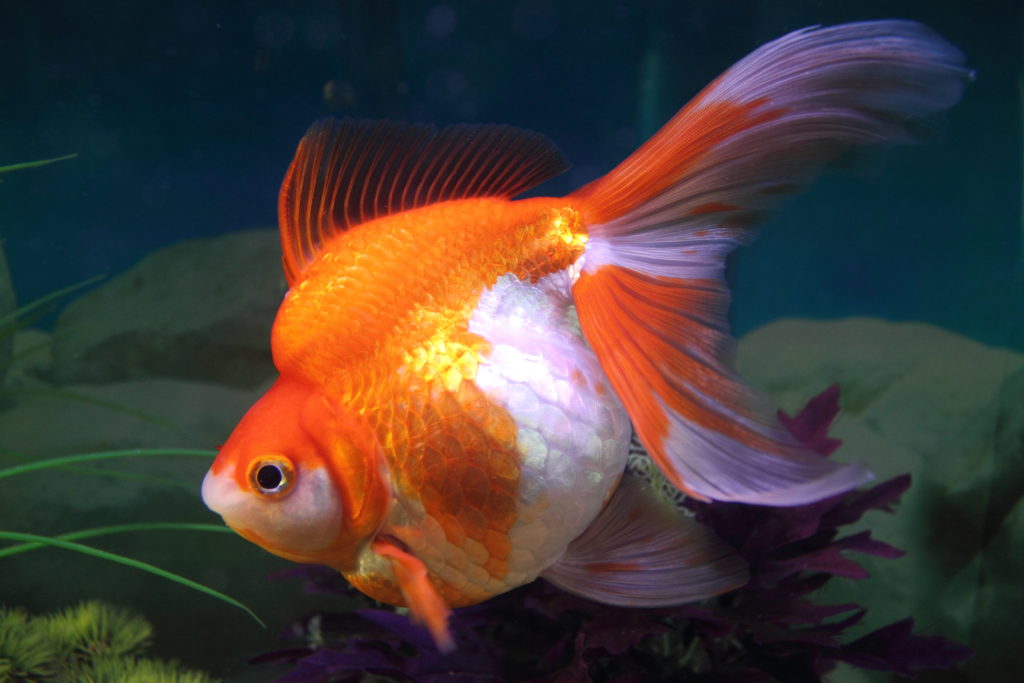
- Ideal Water Temperature: 65 to 72 (F)
- Ideal pH: 7.5 (range from 6 to 8)
- Omnivorous or Carnivorous: Omnivorous
- Harvest Size: N/A
- Harvest Rate: N/A
- Stocking Density: 1 per 10 to 20 gallons
- Light Requirements: Normal lighting
- Backyard or Commercial: Backyard or Indoor
- Can be Bred Within Tank: Yes
- Hardiness: Hardy
- Availability: Easy to find
- Can mix with other fish: Yes
Advantages
- Great fish for beginners
- Hardy fish and easy to monitor
- Aesthetically beautiful
- Easy to find (check local pet stores)
Disadvantages
- Can easily outgrow your tank
- Prone to fish diseases (especially swim bladder and liver disease)
- Tank needs to be kept clean
3. Guppies
For beginners, guppies are a great choice for your aquaponic setup. If you’re looking to do something small just to get your foot in the door, then guppies will do the trick. They can be mixed with other aquarium fish (and will mix well with most of the other aquarium fish listed here) and have a life expectancy of 2 to 3 years.
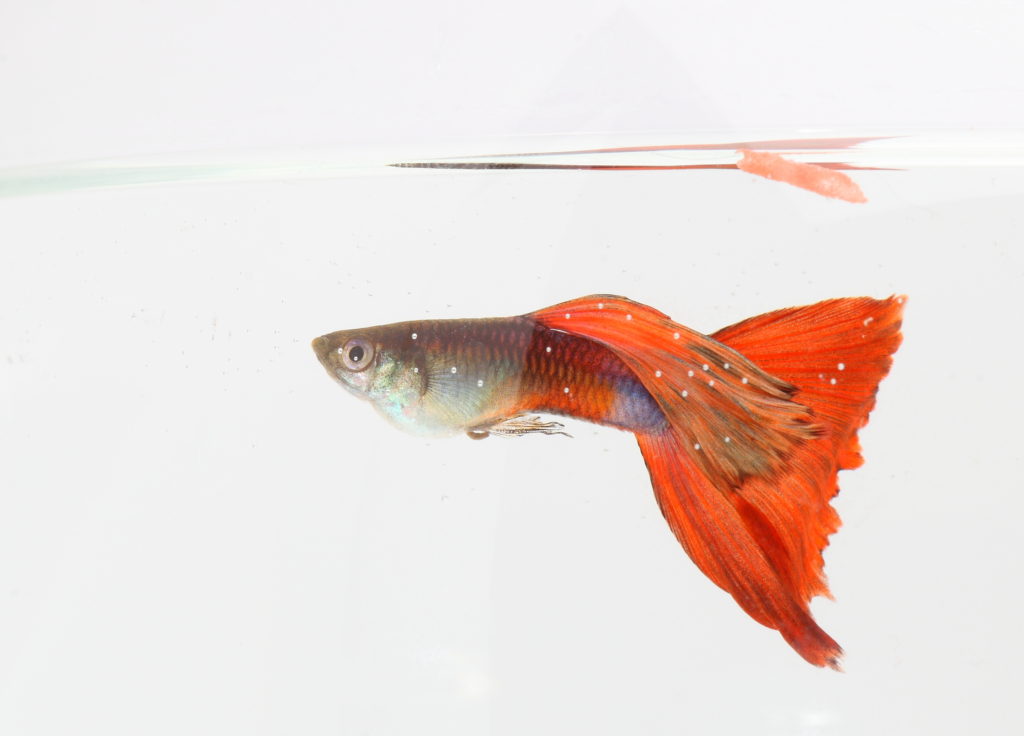
- Ideal Water Temperature: 72 to 78 (F)
- Ideal pH: 6.7 to 8.5
- Omnivorous or Carnivorous: Omnivorous
- Harvest Size: N/A
- Harvest Rate: N/A
- Stocking Density: 8 guppies per 10 gallons
- Light Requirements: Regular lighting
- Backyard or Commercial: Indoor
- Can Be Bred Within Tank: Yes
- Hardiness: High
- Availability: Easy to find
- Can mix with other fish: Yes
Advantages
- Can be found at your local pet store
- Have high hardiness and survivability if cared for correctly
- Reproduce quickly
Disadvantages
- Better suited for small setups
- Similar to other small aquarium fish, they are prone to disease
4. Angelfish
Like other ornamental fish on this list, angelfish have a lot of upside when it comes to aquaponics. As one of the most common freshwater aquarium fish in the world, not only are they aesthetically beautiful, but they meet all of the aquaponic criteria and can live up to 15 years with proper care.
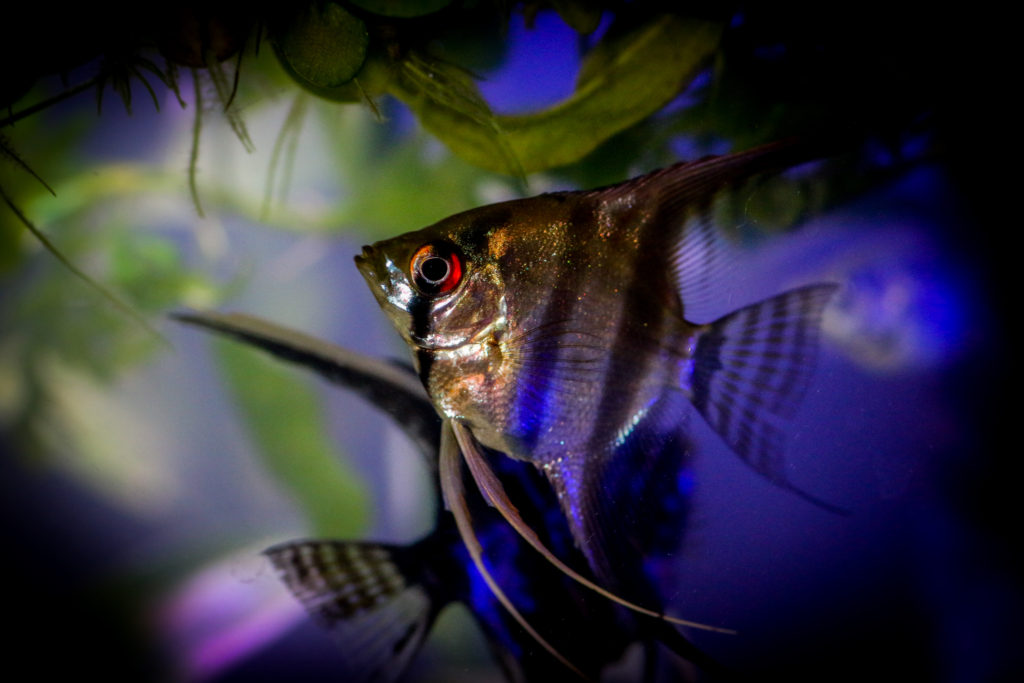
- Ideal Water Temperature: 78 to 84 F
- Ideal pH: 6.8 to 7.8
- Omnivorous or Carnivorous: Carnivorous
- Harvest Size: N/A
- Harvest Rate: N/A
- Stocking Density: 2 fish (adults) per 55 gallons
- Light Requirements: Regular lighting
- Backyard or Commercial: Indoor
- Can be Bred Within Tank: Yes
- Hardiness: Medium
- Availability: Easy to Find
- Can Mix With Other Fish: Not recommended
Advantages
- Grow extremely fast
- Aesthetically beautiful
- Can be found at your local pet store
Disadvantages
- Can get aggressive with other fish after pairing off and finding a mate
- Are not as hardy as some of the other ornamental fish on this list (koi or goldfish)
5. Tetras
Tetras are some of the best fish for aquaponics due to their variety (over 150 different species to choose from) and their adaptability. They get along great with other fish and they have a keen ability to stay calm, cool, and collected inside your tank.
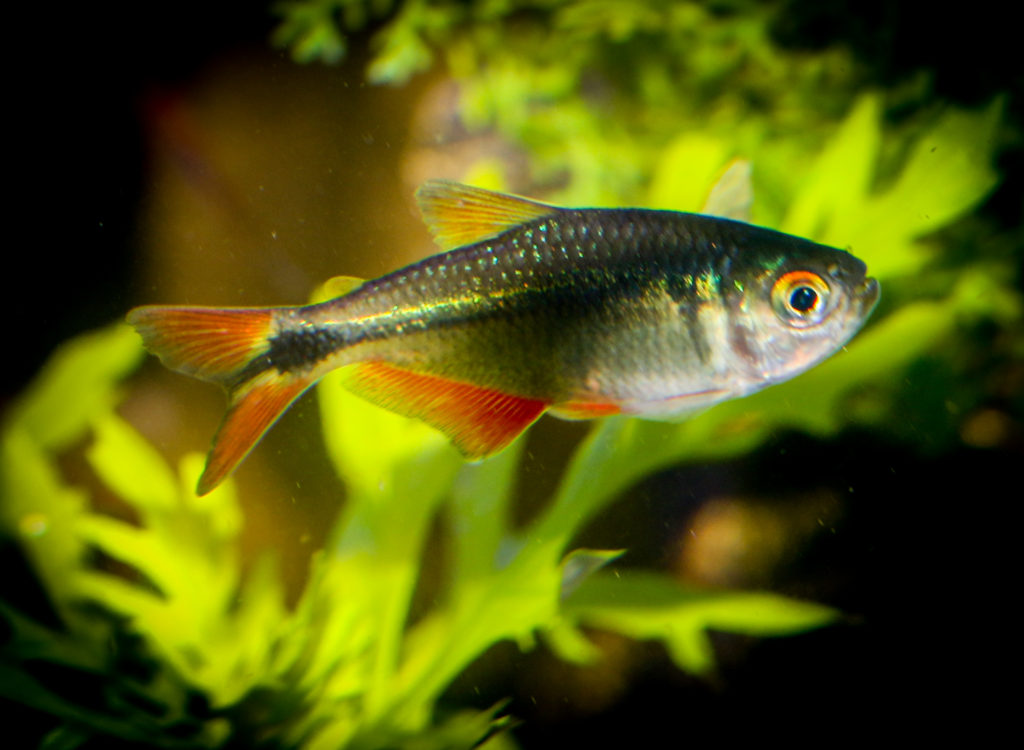
- Ideal Water Temperature: 72 to 81 F
- Ideal pH: 6 to 7
- Omnivorous or Carnivorous: Omnivores
- Harvest Size: N/A
- Harvest Rate: N/A
- Stocking Density: 1 inch of fish per 2 gallons
- Light Requirements: Normal lighting
- Backyard or Commercial: Indoor
- Can be Bred Within Tank: Yes
- Hardiness: High
- Availability: Easy to find
- Can Mix With Other Fish: Yes
Advantages
- Can be mixed with other fish
- Have a peaceful and calm demeanor
- Can put a lot of tetra fish in a relatively small tank
Disadvantages
- Have a habit of eating their young
6. Mollies
Just like tetras, mollies do pretty well in indoor aquaponic systems. They have a lifespan of around 3 to 5 years and grow to about 4 to 4-1/2 inches in length. As a tropical fish, they come in a variety of colors (about 39 species to choose from) and they are all aesthetically beautiful.
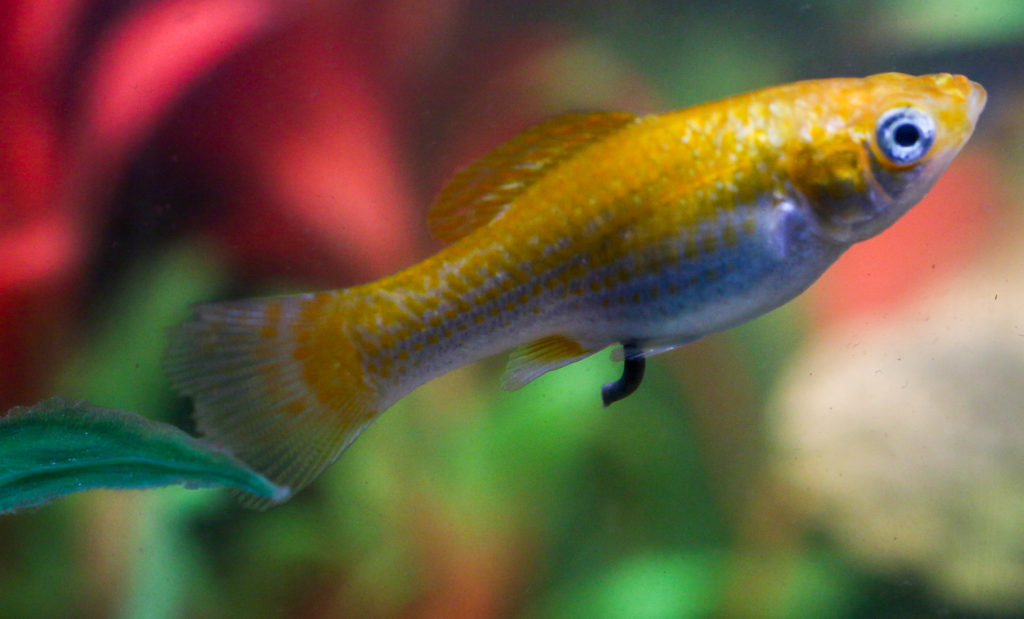
- Ideal Water Temperature: 72 to 78 F
- Ideal pH: 7.5 to 8.5
- Omnivorous or Carnivorous: Omnivores
- Harvest Size: N/A
- Harvest Rate: N/A
- Stocking Density: 4 mollies per 10 gallons
- Light Requirements: Normal lighting
- Backyard or Commercial: Indoor
- Breeding Frequency: High
- Hardiness: Medium
- Availability: Easy to Find
- Can mix with other fish: Yes
Advantages
- Several varieties to choose from
- Peaceful fish and do well with other aquarium fish
- They breed very frequently
Disadvantages
- Are susceptible to “molly disease” known as the “shimmies”
- Their lifespan isn’t as impressive as some of the other ornamental aquaponic fish
7. Swordtail
As with the other aquarium fish on this list, a swordtail’s life expectancy isn’t exactly long (3 to 5 years) but they are a hardy fish nonetheless. Growing to about 5.5 inches in length, swordtail are very adaptable and can be mixed with a variety of other fish. For aquaponics, they would mix great with other similar-sized fish on this list (mollies and tetras especially).
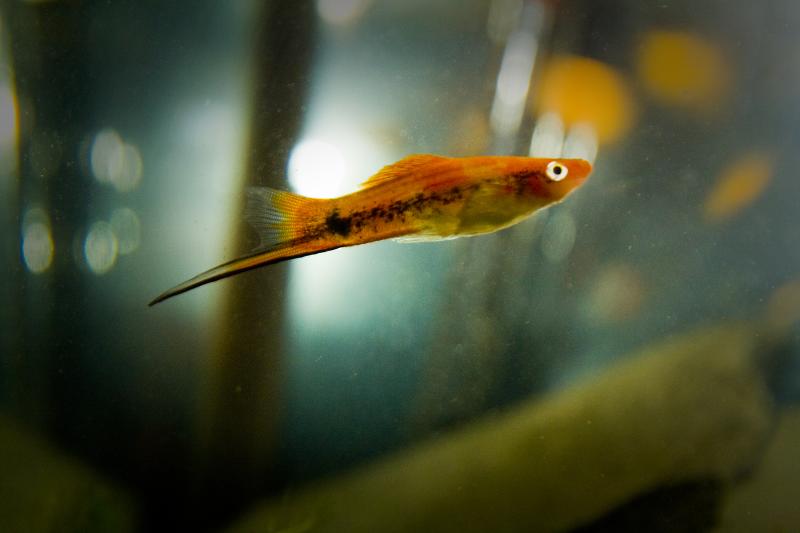
- Ideal Water Temperature: 65 to 72 (F)
- Ideal pH: 7.5 (range from 6 to 8)
- Omnivorous or Carnivorous: Omnivorous
- Harvest Size: N/A
- Harvest Rate: N/A
- Stocking Density: 1 swordtail per 15 gallons
- Light Requirements: Normal lighting
- Backyard or Commercial: Indoor
- Breeding Frequency: High
- Hardiness: High
- Availability: Easy to Find
- Can Mix With Other Fish: Yes
Advantages
- Breed quickly and easily (once every 28 days)
- Several varieties to pick from
Disadvantages
- Males can be territorial
- Require a little more room than some of the other aquarium fish
9. Danios
Danios are one of the smaller fish on this list but they still work well in aquaponic aquarium setups. They have a lifespan of about 2 to 3 years and are capable of reaching 3 inches in length (although they’re normally about 2 to 2.5 inches). Additionally, they’re pretty active and playful, making them great dither fish.
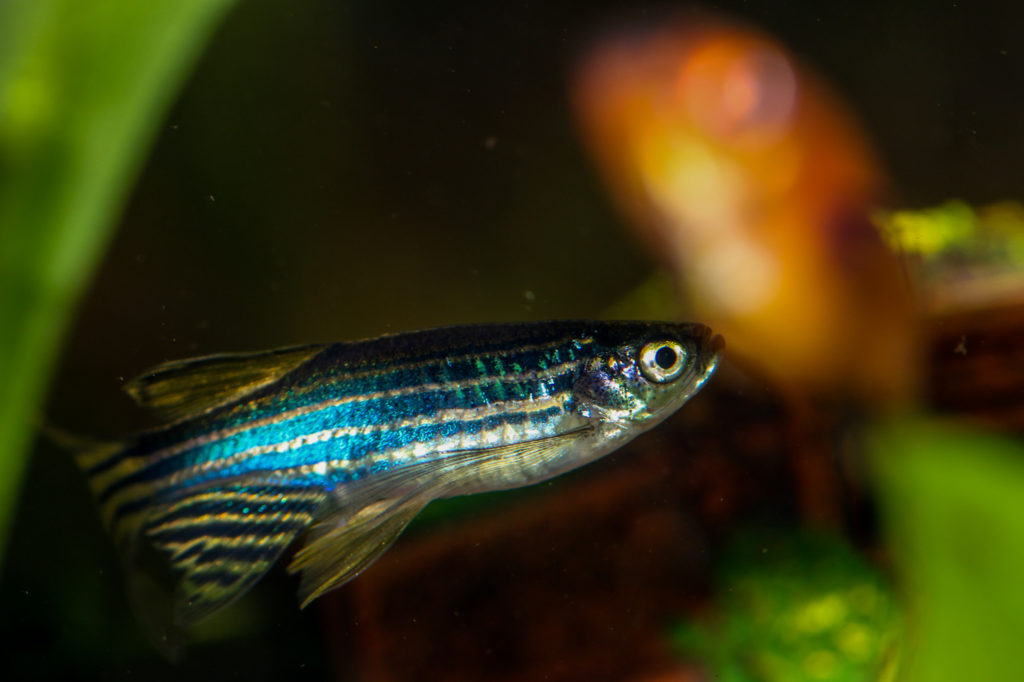
- Ideal Water Temperature: 64 to 82
- Ideal pH: 6.5 to 7.5
- Omnivorous or Carnivorous: Omnivores
- Harvest Size: N/A
- Harvest Rate: N/A
- Stocking Density: 5 per 10 gallons
- Light Requirements: Normal lighting
- Backyard or Commercial: Indoor
- Breeding Frequency: High
- Hardiness: Medium
- Availability: Easy to find
- Can mix with other fish: Yes
Advantages
- Are active and playful and fun to watch
- Have good temperature range
Disadvantages
- Susceptible to Mycobacteriosis and Nematode
- Lifespan is short and they’re not as hardy as some of the other aquarium fish
10. Cichlid
Cichlid come in a variety of colors and types and make great fish for your indoor aquaponics setup. They typically live for about 8 years and grow to 5 inches in length. As a tropical fish, however, they do have high aggression (although some types have less) and they shouldn’t be kept with smaller fish.
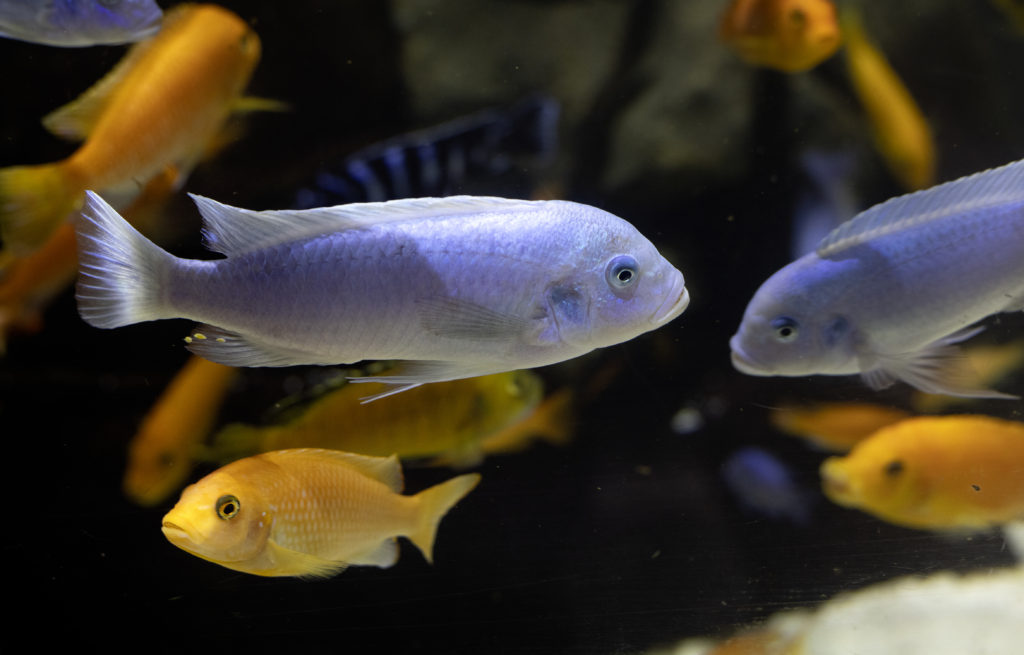
- Ideal Water Temperature: 75 to 85 F
- Ideal pH: 6.5 to 8.5
- Omnivorous or Carnivorous: Omnivores
- Harvest Size: N/A
- Harvest Rate: N/A
- Stocking Density: 1 fish per 20 to 30 gallons
- Light Requirements: Normal lighting
- Backyard or Commercial: Indoor
- Can Be Bred Within Tank: Yes
- Hardiness: High
- Availability: Easy to find
- Can Mix With Other Fish: Usually not
Advantages
- Tropical fish and aesthetically beautiful
- Lots of colors and varieties to pick from
Disadvantages
- Territorial fish that require plenty of hiding spaces
- Temperature range isn’t great
- Can be aggressive with other fish
11. Clown Loach
Clown loaches are easy to care for and make great aquarium fish for any aquaponic setup. As a colorful fish, they’ll happily dance around your aquarium and put on a show. And despite their small appearance when they’re sold, clown loach actually grow to 12 inches in length and can live 10 years or more.
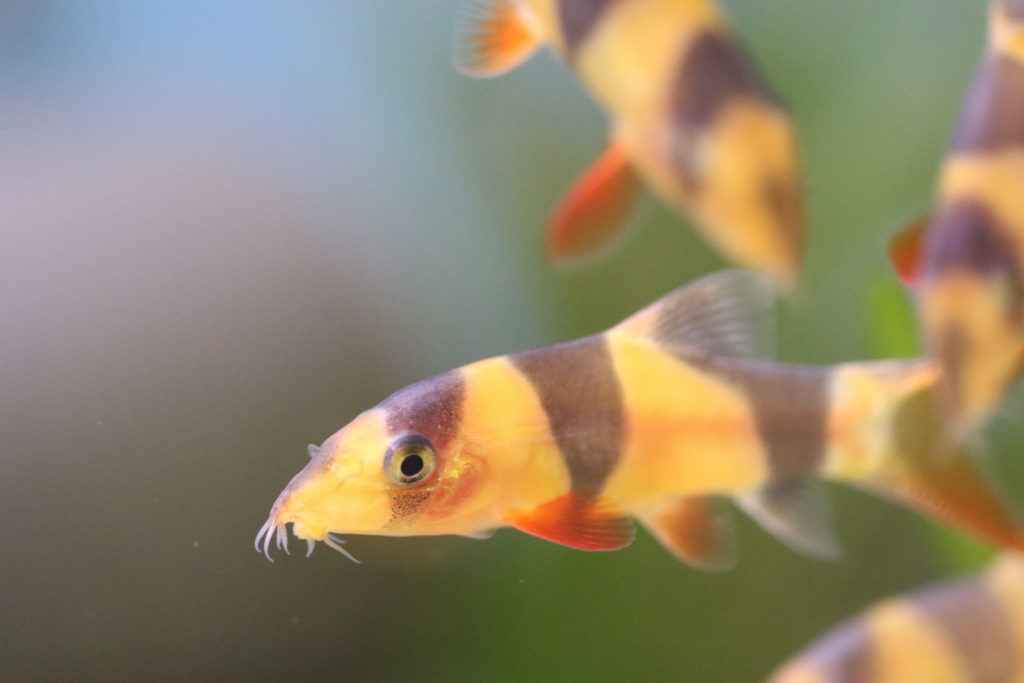
- Ideal Water Temperature: 72 to 86 F
- Ideal pH: 6 to 7.5
- Omnivorous or Carnivorous: Omnivores
- Harvest Size: N/A
- Harvest Rate: N/A
- Stocking Density: 1 adult per 30 gallons
- Light Requirements: Prefer low light
- Backyard or Commercial: Indoor
- Can Be Bred Within Tank: Yes
- Hardiness: Medium
- Availability: Easy to find
- Can Mix With Other Fish: Yes
Advantages
- Have great color and are fun to watch
- Extremely long lifespan if conditions are right (some reports of 25 years)
Disadvantages
- Because they grow to be quite large, they require very large tanks
- Not as hardy as some of the other fish on this list
- Susceptible to ich
Possible but Challenging Fish for Aquaponics
Technically, any freshwater fish can be used for aquaponics, but that doesn’t mean you SHOULD use them. For beginners, it’s probably best to go with a “tried and tested” fish (like Tilapia or Koi) before trying anything else. But, if you’ve been there done that, and you’re looking to do some experimentation, here’s a quick list of fish that have been successfully grown in aquaponic systems but may be a little bit challenging.
1. Barramundi
The barramundi should probably be avoided in aquaponic systems. It can be done, yes, but it’s not exactly ideal or efficient. Because of their tank space requirements and temperature/pH range, their survivability rate isn’t great. However, if there is one plus to barramundi, it’s that they do grow relatively fast and can be harvested in less than a year.
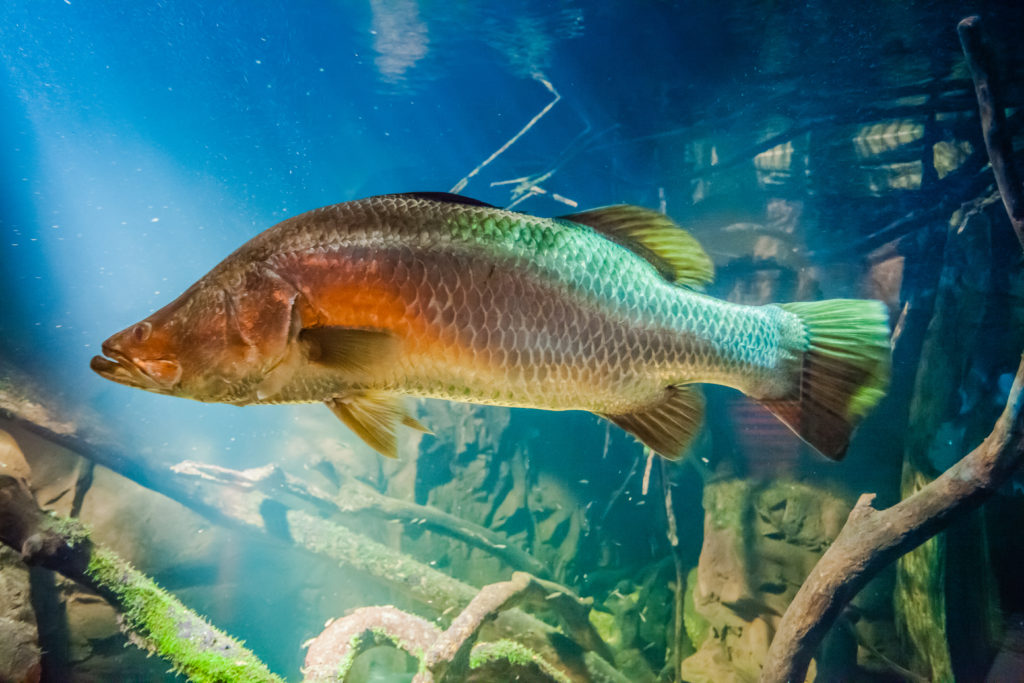
- Ideal Water Temperature: 77 to 86 F
- Ideal pH: 6.5 to 7.2
- Omnivorous or Carnivorous: Carnivorous
- Harvest Size: 2 to 3 pounds
- Harvest Rate: 6 or 7 months
- Stocking Density: Medium
- Light Requirements: Some sunlight
- Backyard or Commercial: Both
- Can Be Bred Within Tank: Difficult
- Hardiness: Medium
- Availability: Not easy to find
- Can mix with other fish: No
Advantages
- Extremely fast growers
- Are considered good eating in certain areas
Disadvantages
- Because barramundi produce a lot of waste, water quality requirements are difficult to manage. They need high DO, warm water, and have a very limited pH range
- Because they are fast growers, they need a large amount of tank space
- Fingerlings tend to be cannibalistic and eat one another
2. Walleye
Walleye have shown a lot of promise in aquaponics, but they’re in our challenging column for two reasons: (1) they are difficult to find (lack of fry supply), and (2) there’s just not a whole lot of trustworthy information on them yet. However, there have been plenty of people who have claimed to make them work. So, if you’re up for a challenge, then they’re certainly worth a try.

- Ideal Water Temperature: 68 to 75 F
- Ideal pH: 6.5 to 9
- Omnivorous or Carnivorous: Carnivorous
- Harvest Size: 1.25 pounds
- Harvest Rate: 3 years (somewhat unknown)
- Stocking Density: Somewhat unknown in aquaponics. General consensus is 1 pound of fish per 2 gallons of water.
- Light Requirements: Normal light
- Backyard or Commercial: Both
- Can Breed Within Tank: Yes
- Hardiness: High
- Availability: Difficult to find
- Can Mix With Other Fish: Yes (if same size or bigger)
Advantages
- Many Hobbyist have reported growing walleye successfully in aquaponics
- Are supposed to be fairly hardy fish
Disadvantages
- Lack of scientific information/findings for Walleye in aquaponic systems
- Conflicting information on them via online sources (for aquaponics)
- Very difficult to find a fry supplier
- As a predatory fish, it can’t be kept with fish that are smaller
3. Hybrid Striped Bass
As a hybrid between striped bass and white bass, the hybrid striped bass will work well in aquaponic systems but it definitely has some downsides. For one, hybridization doesn’t occur naturally and they have to be cultured from a hatchery. Secondly, they don’t tolerate potassium very well which isn’t exactly ideal for plant pairings.
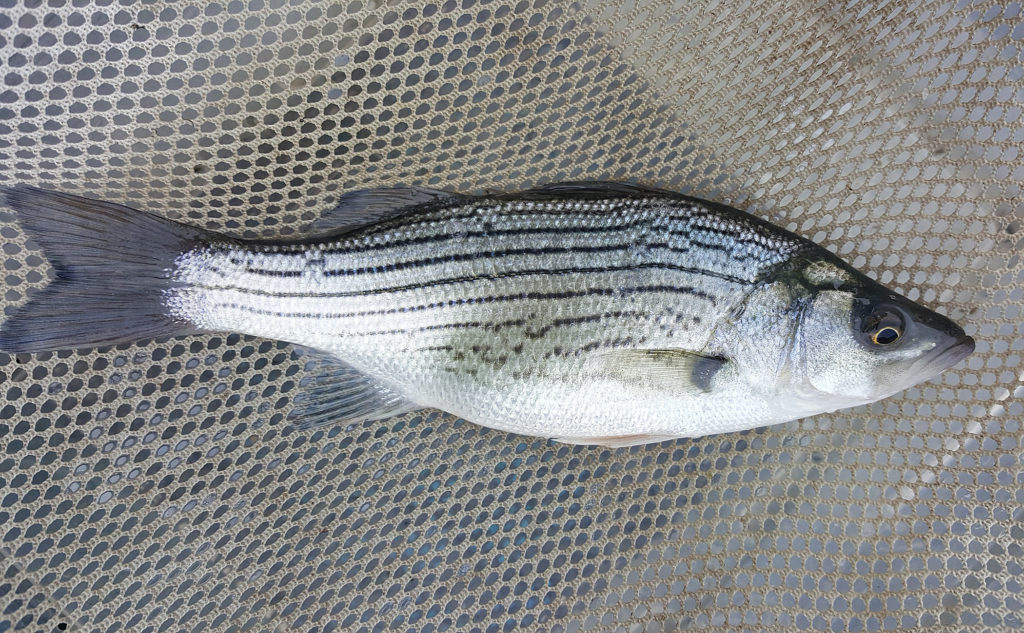
- Ideal Water Temperature: 77 and 81 F
- Temperature Range: 39 to 84 F
- Ideal pH: 7.5 to 8.5
- Omnivorous or Carnivorous: Carnivorous
- Harvest Size: 1 to 3 pounds
- Harvest Rate: 18 months
- Stocking Density: Somewhat unknown in aquaponics. General consensus is 50 per 300 gallons
- Light Requirements: Normal lighting
- Backyard or Commercial: Both
- Can Breed Within Tank: No
- Hardiness: High
- Availability: Easy to find
- Can mix with other fish: Yes
Advantages
- Good tasting fish that has a lot of flavor
- Hybrid Striped Bass are very hardy and tolerant of environmental changes
- Can tolerate low dissolved oxygen (DO)
Disadvantages
- Most reports indicate that it isn’t the most efficient fish to pair with plants
- Hybridization doesn’t occur naturally
- There’s not a lot of information on hybrid striped bass in aquaponic systems yet
4. Largemouth Bass
Similar to hybrid striped bass, plenty of people have made largemouth bass work for their aquaponics system (or at least plenty of people have experimented with them), but the general consensus is that they’re pretty difficult for beginners. Unfortunately, they’re a little disease prone in tanks and are on the expensive side to purchase and maintain.
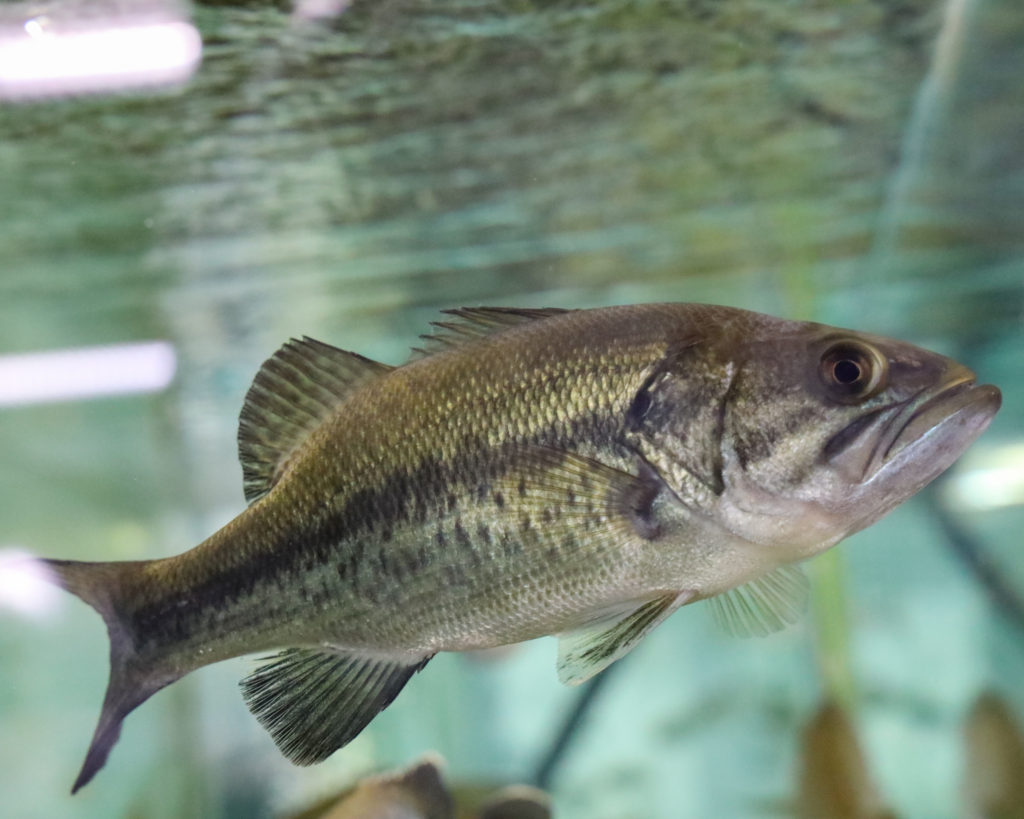
- Ideal Water Temperature: 65˚ to 85˚ F
- Temperature Range: 60˚ to 96˚ F
- Ideal pH: 7 to 8
- Omnivorous or Carnivorous: Carnivorous
- Harvest Size: 1.25 pounds
- Harvest Rate: 12 to 18 months
- Stocking Density: 150 gallons per 8 fish
- Light Requirements: Indirect sunlight and shade
- Backyard or Commercial: Both
- Can Breed Within Tank: Yes
- Hardiness: High (if given room)
- Availability: Easy to find
- Can mix with other fish: Not recommended
Advantages
- Can achieve a pound of fish per year
- Tasty and popular game fish
Disadvantages
- Prone to diseases in tanks (especially Columnaris)
- Expensive to buy and produce (comparatively)
- Don’t handle small tanks well
- Cannibalistic
5. Trout
Of all the trout species used in aquaponics, rainbow trout are the most popular. They’re good tasting, they grow really fast, and they can be stocked pretty well (relatively at least). However, due to their less-than-ideal temperature range, they can only be paired with cool-weather crops. And while that means they will certainly pair well with cool-weather vegetables like lettuce, so too do more reliable fish, such as koi. So regardless of what you’re growing, it’s probably best to go with another fish (unless you want a challenge of course!).
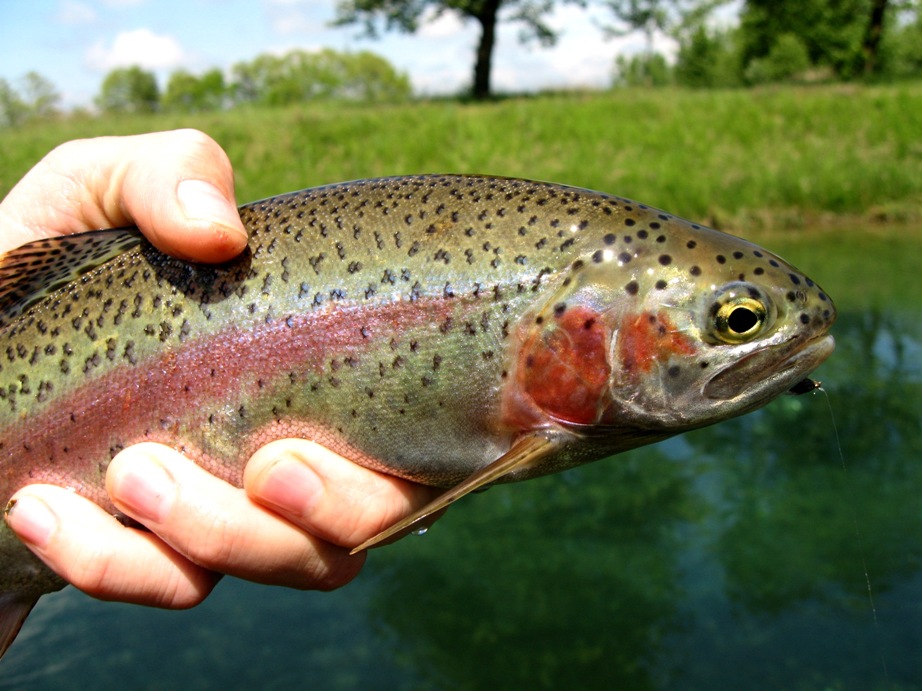
- Ideal Water Temperature: Around 59 F (15 C)
- Temperature Range: 50 to 68 F
- pH: 6 to 8
- Omnivorous or Carnivorous: Carnivorous
- Harvest Size: less than a pound
- Harvest Rate: 7 to 8 months
- Stocking Density: 60 to 80 trout per 265 gallons
- Light Requirements: Normal light
- Backyard or Commercial: Both
- Can Breed Within Tank: Yes
- Hardiness: High
- Availability: Easy to find
- Can mix with other fish: No
Advantages
- Great-tasting fish
- Grow quickly and easy to harvest
Disadvantages
- Less than ideal temperature range
- Can only be paired with cool weather crops
- Require high levels of oxygen
6. Salmon
Just like the rest of the fish on this “challenging” list, salmon have been successfully grown in aquaponics, but that doesn’t necessarily mean they’re a good fit for you. Because they’re prone to diseases, have a very specific temperature range, and have very particular developmental requirements, they’re just not an easy fish to work with in aquaponics. Additionally, there’s really not a whole lot of information on them yet.
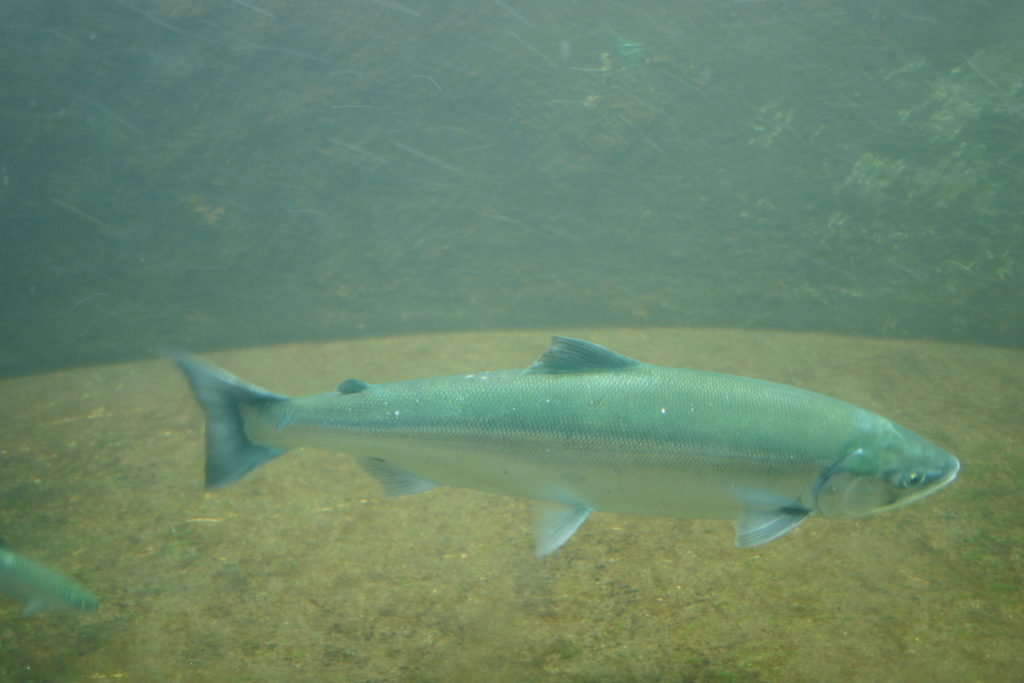
- Ideal Water Temperature: 59 to 63
- Ideal pH: 6.5 to 8.5
- Omnivorous or Carnivorous: Carnivorous
- Harvest Size: 8.8 pounds
- Harvest Rate: 9 months
- Stocking Density: 0.125 pounds of fish per gallon
- Light Requirements: Normal lighting
- Backyard or Commercial: Commercial
- Can Breed Within Tank: Difficult
- Hardiness: Medium
- Availability: Difficult to find
- Can mix with other fish: Not recommended
Advantages
- Salmon grow almost a pound per month
- Salmon are tasty and one of the most sought after fish
Disadvantages
- Salmon will cannibalize smaller fish
- Because of salmon’s temperature requirements, salmon can be hard to pair with a plant
- Salmon are very disease prone in the early stages and have high mortality
- Very difficult to run and maintain a nursery
- Salmon make more sense for commercial setups
7. Murray Cod
If you know what you’re doing, then murray cod can be a lot of fun to raise in your backyard setup, but they’re definitely not for beginners. While they do grow fast (and very large for that matter), they are very susceptible to illness and require an extremely large tank space. Overall, they can be pretty difficult to manage and keep alive.
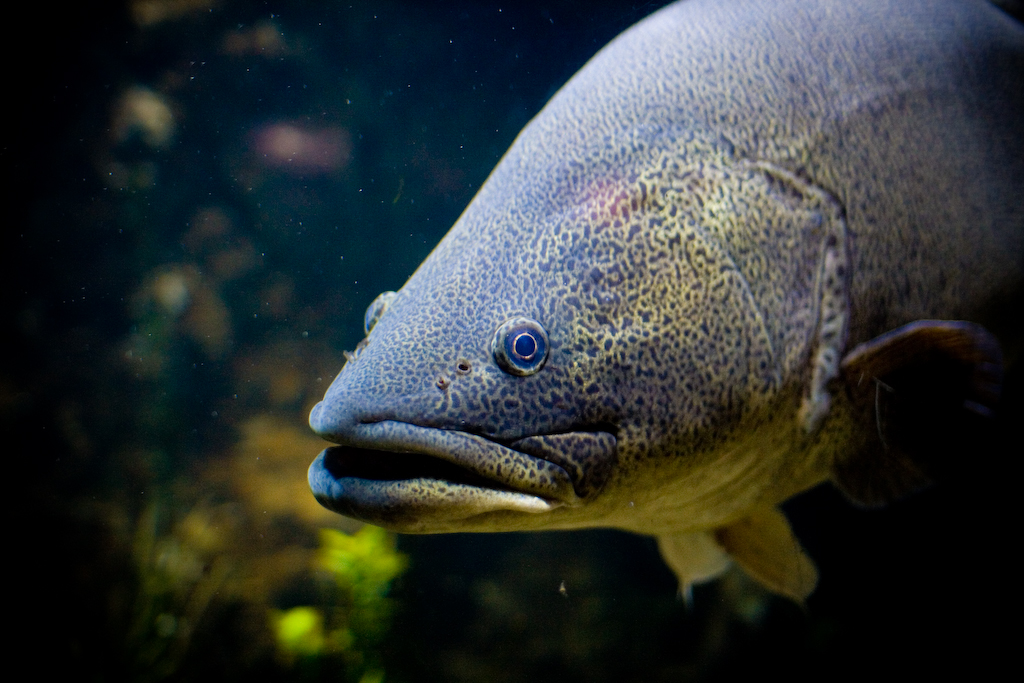
- Ideal Water Temperature: 75 to 77 (F)
- pH Requirements: 6 to 8
- Omnivorous or Carnivorous: Carnivorous
- Harvest Size: 1.25 pounds
- Harvest Rate: 15 months
- Stocking Density: 1 adult fish per 250 gallons
- Light Requirements: Tank with window
- Backyard or Commercial: Both
- Can Breed Within Tank: Possible
- Hardiness: High
- Availability: Not easy to find
- Can Mix With Other Fsh: No
Advantages
- One of the faster growing fish for aquaponics
- One of the larger fish for aquaponic systems
- Good tasting fish that’s easy to clean
Disadvantages
- Require a lot of tank space
- Susceptible to bacteria and fungal infections
- Cannot mix with other fish (tend to eat other fish)
- They prefer hiding spaces within their tank
This list is a culmination of online educational and informational resources; however, we do recognize that conflicting information does exist across the internet due to the nature of aquaponics. If you see something that needs to be fixed on our list, send us a message and let us know!






